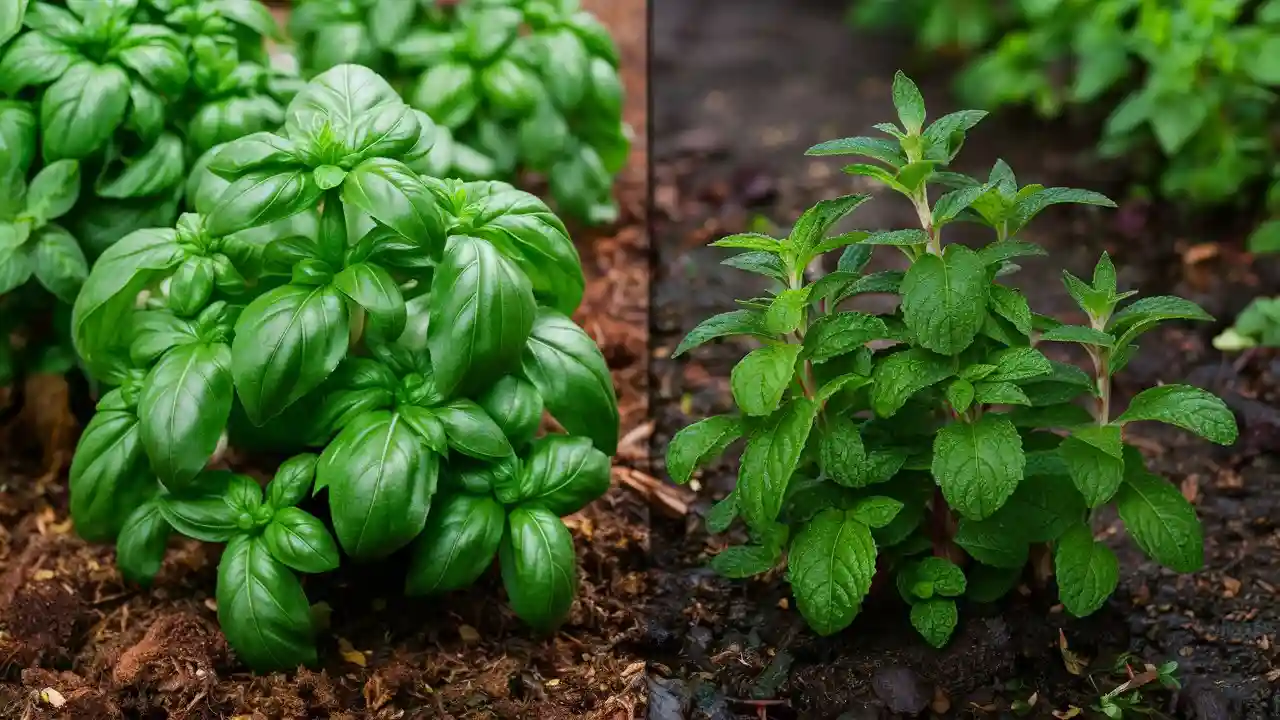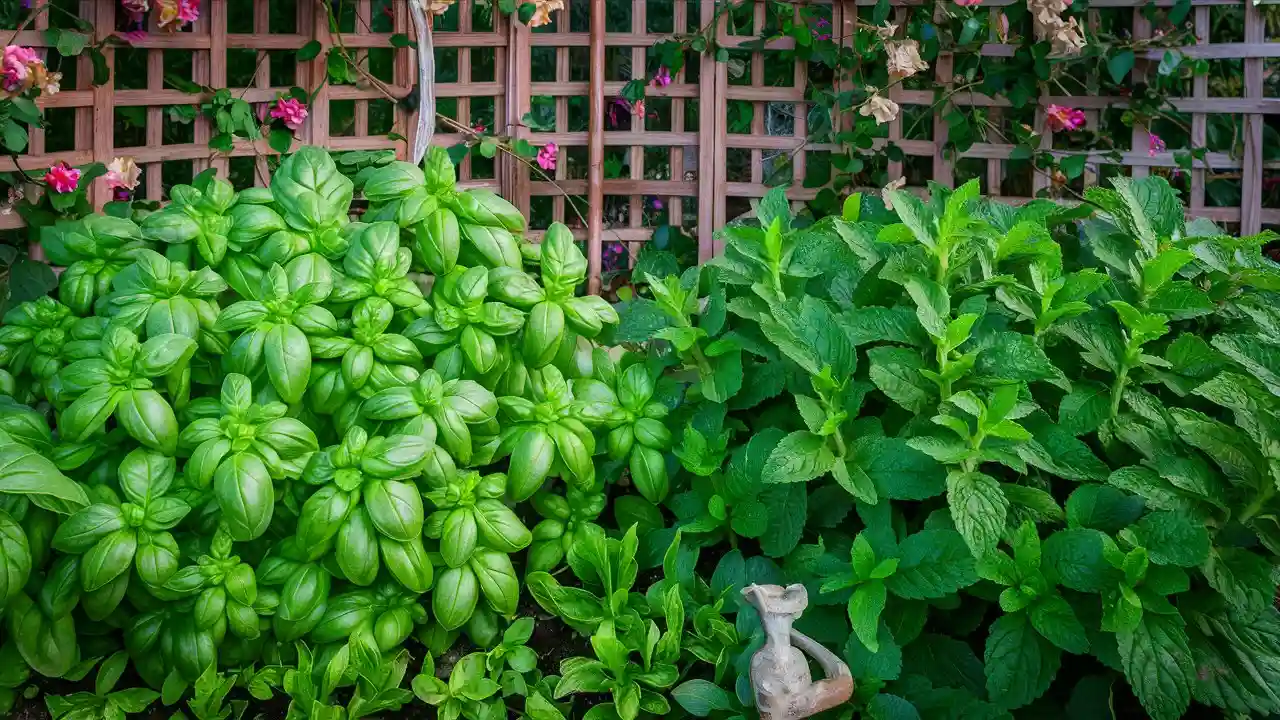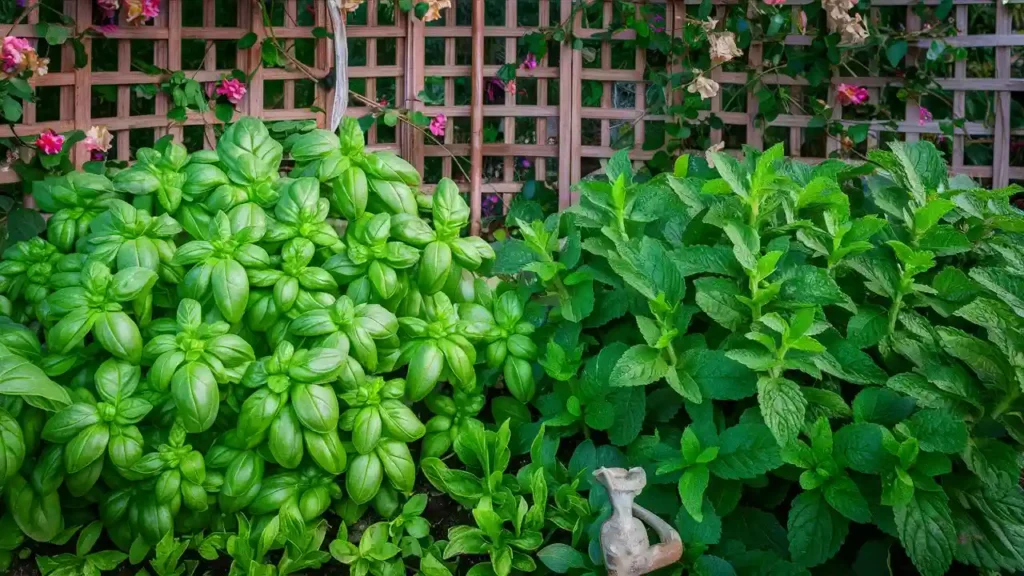
Can I Plant Basil And Mint Together
Basil and mint are two popular herbs that are often used in cooking. They can both be grown in the same garden, but there are a few things to keep in mind. Basil prefers well-drained soil and full sun, while mint prefers moist soil and partial shade. If you plant them together, be sure to choose a location that meets the needs of both plants. Another thing to keep in mind is that mint can be invasive. It can quickly spread and take over a garden. If you are concerned about this, you can plant mint in a container or raised bed. With a little care, you can successfully grow basil and mint together in your garden.
How to Plant Basil and Mint Together
Planting basil and mint together is a great way to save space in your garden and have both herbs readily available for use. Here are a few tips for planting basil and mint together:
Choose the right location. Basil and mint both prefer full sun to partial shade and well-drained soil. If you are planting them in containers, make sure the pots have drainage holes.
Plant the basil and mint seedlings 12-18 inches apart. This will give them enough space to grow and spread without crowding each other.
Water the basil and mint regularly. Both of these herbs need regular watering, especially during hot weather.
Fertilize the basil and mint every few weeks. A balanced fertilizer will help them grow healthy and strong.
Harvest the basil and mint leaves as needed. You can harvest the leaves by pinching them off the stems. Basil and mint can be used fresh or dried.
Growing Basil and Mint in Containers
If you don’t have a garden bed, you can still grow basil and mint together in containers. This is a great option for apartment dwellers or those with limited space. Choose a container that is at least 12 inches in diameter and has drainage holes. Fill the container with a well-draining potting mix. Plant the basil and mint seedlings 6 inches apart. Water the plants regularly, especially during hot weather. Fertilize the plants every few weeks with a balanced fertilizer.
Tips for Growing Basil and Mint in Containers:
- Choose a container that is large enough to accommodate the root systems of both plants.
- Use a well-draining potting mix to prevent the roots from rotting.
- Water the plants regularly, especially during hot weather.
- Fertilize the plants every few weeks with a balanced fertilizer.
- Prune the plants regularly to encourage new growth.
- Harvest the leaves as needed.
Basil and Mint Companion Planting
Basil and mint are two popular culinary herbs that are often used in cooking. They are both relatively easy to grow, and they can be grown together in the same container or garden bed. However, there are a few things to keep in mind when companion planting basil and mint.
First, it is important to choose the right varieties of basil and mint. Some varieties of basil are more compatible with mint than others. For example, sweet basil is a good choice for companion planting with mint, while lemon basil is not. Similarly, spearmint is a good choice for companion planting with basil, while peppermint is not.
Second, it is important to plant basil and mint at the right time. Basil is a warm-season herb, while mint is a cool-season herb. This means that basil should be planted after the last frost, while mint can be planted in the early spring or fall.
Finally, it is important to provide basil and mint with the right growing conditions. Basil prefers full sun and well-drained soil, while mint prefers partial shade and moist soil. If you are planting basil and mint in the same container, be sure to use a potting mix that is well-drained and contains plenty of organic matter.

Planting Basil and Mint Together
Basil and mint can be planted together successfully, as they have similar growing requirements and do not compete for the same resources. They both prefer well-drained soil, full sun to partial shade, and regular watering. However, there are a few things to keep in mind when planting these herbs together:
- Plant spacing: Basil and mint should be planted at least 12 inches apart to allow for good air circulation and prevent disease.
- Watering: Basil needs more water than mint, so be sure to water the plants accordingly.
- Fertilizing: Both basil and mint benefit from regular fertilizing. Use a balanced fertilizer and follow the directions on the package.
- Pruning: Basil and mint should be pruned regularly to encourage new growth. Pinch back the tips of the stems to promote bushier plants.

Basil and Mint Compatibility
Basil and mint are both members of the Lamiaceae family, which also includes herbs such as oregano, thyme, and rosemary. They are both relatively easy to grow and can be planted in a variety of climates. However, there are some important things to keep in mind when planting basil and mint together.
Basil is a warm-season herb that prefers full sun and well-drained soil. It is susceptible to cold temperatures and can be damaged by frost. Mint, on the other hand, is a cool-season herb that prefers partial shade and moist soil. It is more tolerant of cold temperatures than basil and can even overwinter in some climates.
Because of their different growing requirements, basil and mint are not ideal companion plants. Basil will likely outgrow mint in full sun, and mint may crowd out basil in partial shade. Additionally, mint can be invasive and spread quickly, so it is important to keep it under control when planting it near other herbs.
If you are determined to plant basil and mint together, there are a few things you can do to increase your chances of success. First, choose a variety of mint that is less invasive, such as spearmint or peppermint. Second, plant the basil and mint in separate containers or in different parts of the garden. This will help to prevent the mint from crowding out the basil.
Companion Planting Basil and Mint
Companion planting is a gardening technique that involves planting two or more different plant species together to create a mutually beneficial relationship. Basil and mint are two herbs that are often companion planted because they have complementary growing habits and can benefit each other in several ways.
Improved growth: Basil is a heavy feeder that requires a lot of nutrients to grow well. Mint, on the other hand, is a relatively low-maintenance herb that does not require as much fertilizer. When these two herbs are planted together, the basil can benefit from the extra nutrients provided by the mint, while the mint can benefit from the basil’s shade and protection from pests.
Pest control: Mint is a natural insect repellent, and its strong scent can help to deter pests from basil plants. Additionally, the dense foliage of mint can provide a physical barrier that makes it difficult for pests to reach the basil.
Improved flavor: Some gardeners believe that companion planting basil and mint can improve the flavor of both herbs. The strong, minty flavor of mint can complement the sweet, peppery flavor of basil, creating a more complex and flavorful combination.

Basil and Mint Gardening Tips
Soil preparation: Basil and mint prefer well-drained, fertile soil with a pH between 6.0 and 7.0. Amend the soil with compost or manure before planting to improve drainage and fertility.
Planting: Plant basil and mint seedlings or transplants 12-18 inches apart. Water the plants deeply after planting and mulch around them to retain moisture and suppress weeds.
Watering: Basil and mint require regular watering, especially during hot, dry weather. Water the plants deeply at the base, avoiding getting the leaves wet as this can promote disease.
Fertilizing: Fertilize basil and mint every few weeks with a balanced fertilizer. Avoid over-fertilizing, as this can lead to leggy growth and reduce flavor.
Pruning: Pinch back the tips of basil and mint plants to encourage bushier growth and prevent them from becoming leggy. Remove any dead or diseased leaves or stems.
Benefits of Companion Planting Basil and Mint
Companion planting basil and mint offers several advantages for your garden:
- Improved growth: Basil and mint are known to benefit from each other’s presence. Basil helps repel insects that can harm mint, while mint helps improve the growth and flavor of basil.
- Pest control: Mint is a natural insect repellent, and its strong aroma can help keep pests away from both basil and other nearby plants.
- Increased yield: Companion planting basil and mint can lead to increased yields of both herbs. The improved growth and pest control provided by this pairing can result in a more bountiful harvest.
- Space optimization: Planting basil and mint together can help you save space in your garden. These herbs can be grown nearby without competing for resources, making them ideal for small spaces or container gardening.
- Enhanced flavor: The flavors of basil and mint complement each other well. Planting them together can enhance the taste of both herbs, making them more flavorful for culinary use.

Harvesting and Using Basil and Mint
Once your basil and mint plants are established, you can begin harvesting the leaves for use in cooking or other purposes.
Basil:
- Harvest basil leaves by pinching or cutting them off the stem.
- Basil can be used fresh or dried.
- Fresh basil leaves can be added to salads, soups, sauces, and other dishes.
- Dried basil leaves can be used in rubs, marinades, and other seasonings.
Mint:
- Harvest mint leaves by pinching or cutting them off the stem.
- Mint can be used fresh or dried.
- Fresh mint leaves can be added to salads, teas, desserts, and other dishes.
- Dried mint leaves can be used in teas, potpourris, and other products.
Both basil and mint are versatile herbs that can be used in a variety of ways. Experiment with different recipes and uses to find your favorite ways to enjoy these flavorful plants.
Troubleshooting Basil and Mint Companion Planting
While basil and mint are generally compatible companion plants, there are a few potential issues that you may encounter:
- Mint can be invasive: Mint tends to spread aggressively through its roots and stolons. If you’re not careful, it can quickly take over your garden and crowd out other plants. To prevent this, plant mint in a container or use root barriers to contain its growth.
- Basil can attract pests: Basil is a favorite of aphids, spider mites, and other pests. If you’re growing basil and mint together, check your plants regularly for pests and take steps to control them if necessary.
- Water requirements: Basil and mint have different water requirements. Basil prefers well-drained soil, while mint prefers moist soil. If you’re planting them together, make sure to adjust your watering schedule accordingly.
By following these tips, you can successfully grow basil and mint together and enjoy the benefits of companion planting.
Frequently Asked Questions
Can I plant basil and mint together?
Yes, basil and mint can be planted together. They are both relatively easy to grow and have similar growing requirements.
What are the benefits of companion planting basil and mint?
Companion planting basil and mint offers several benefits, including improved growth, pest control, increased yield, space optimization, and enhanced flavor.
How do I plant basil and mint together?
To plant basil and mint together, choose a location with well-drained soil and full sun to partial shade. Plant the basil and mint seedlings 12-18 inches apart. Water the plants regularly and fertilize them every few weeks.
How do I harvest basil and mint?
To harvest basil and mint, pinch or cut the leaves off the stem. Basil and mint can be used fresh or dried.
What are some troubleshooting tips for companion planting basil and mint?
Some potential issues you may encounter when companion planting basil and mint include mint’s invasiveness, basil’s susceptibility to pests, and their different water requirements. To address these issues, plant mint in a container or use root barriers, check your plants regularly for pests take steps to control them if necessary, and adjust your watering schedule accordingly.
